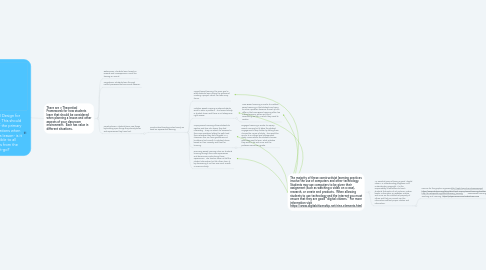
1. There are 3 Theoretical Frameworsk for how students learn that should be considered when planning a lesson and other aspects of your classroom environment. Each has value in different situations.
1.1. Behaviorism: Students learn based on rewards and consequences, much like training an animal.
1.2. Cognitivism: Students learn through mental processes that we cannot observe.
1.3. Constructivism: Students learn new things by building upon things they already know and experiences they have had.
1.3.1. Constructivist teaching relies heavily on hand-on experiential learning.
1.3.1.1. Project based learning- the main goal is what students learn during the process of creating a project, which can take many forms.
1.3.1.2. Problem Based Learning is where students work to solve a problem. The lesson/activity is student driven and there is not always one right answer.
1.3.1.2.1. Case Based Learning is similar to Problem Based Learning in that students are trying to solve a problem however the set up can differ in that Case Based Learning often has a story/scenario, either real life or resembling real life, in which they need to resolve.
1.3.1.3. Inquiry Based Learning allows students to explore and dive into topics they find interesting. They can search for answers to their own questions letting the path lead them wherever they feel intrigued. In a classroom this can have guidelines and limitations, but overall it is student driven based on their curiosity and thirst for learning.
1.3.1.3.1. Engaged Learning is similar to Inquiry Based Learning but it takes the student engagement a step further by letting them choose the course of study. This would be similar to a college level independent study course where the student chooses what they want to learn, what activities they want to do and more and the professor serves as a guide.
1.3.1.4. Discovery Based Learning relies on students learning through their own experiences and discoveries made during those experiences. The teacher does not tell the student information but let's them learn it by discovering it on their own such as with a science activity.
2. The majority of these constructivist learning practices involve the use of computers and other technology. Students may use computers to be given their assignment (such as watching a video on a case), research, or create end products. When allowing students to use technology and the internet you must ensure that they are good "digital citizens." For more information visit https://www.digitalcitizenship.net/nine-elements.html
2.1. An essential piece of being a good "digital citizen" is understanding plagiarism and understanding copyright. It is the responsibility of educators to teach students that works of art, pictures, videos, books, information on websites, articles and more are the intellectual property of others and that you cannot use this information without proper citation and information.
2.1.1. Sources for this graphic organizer:http://ozpk.tripod.com/000engaged https://www.edutopia.org/blog/what-heck-inquiry-based-learning-heather-wolpert-gawron http://en.wikipedia.org/wiki/Discovery_learning Case-Based Learning | Centre for Teaching and Learning https://player.vimeo.com/video/23661749
